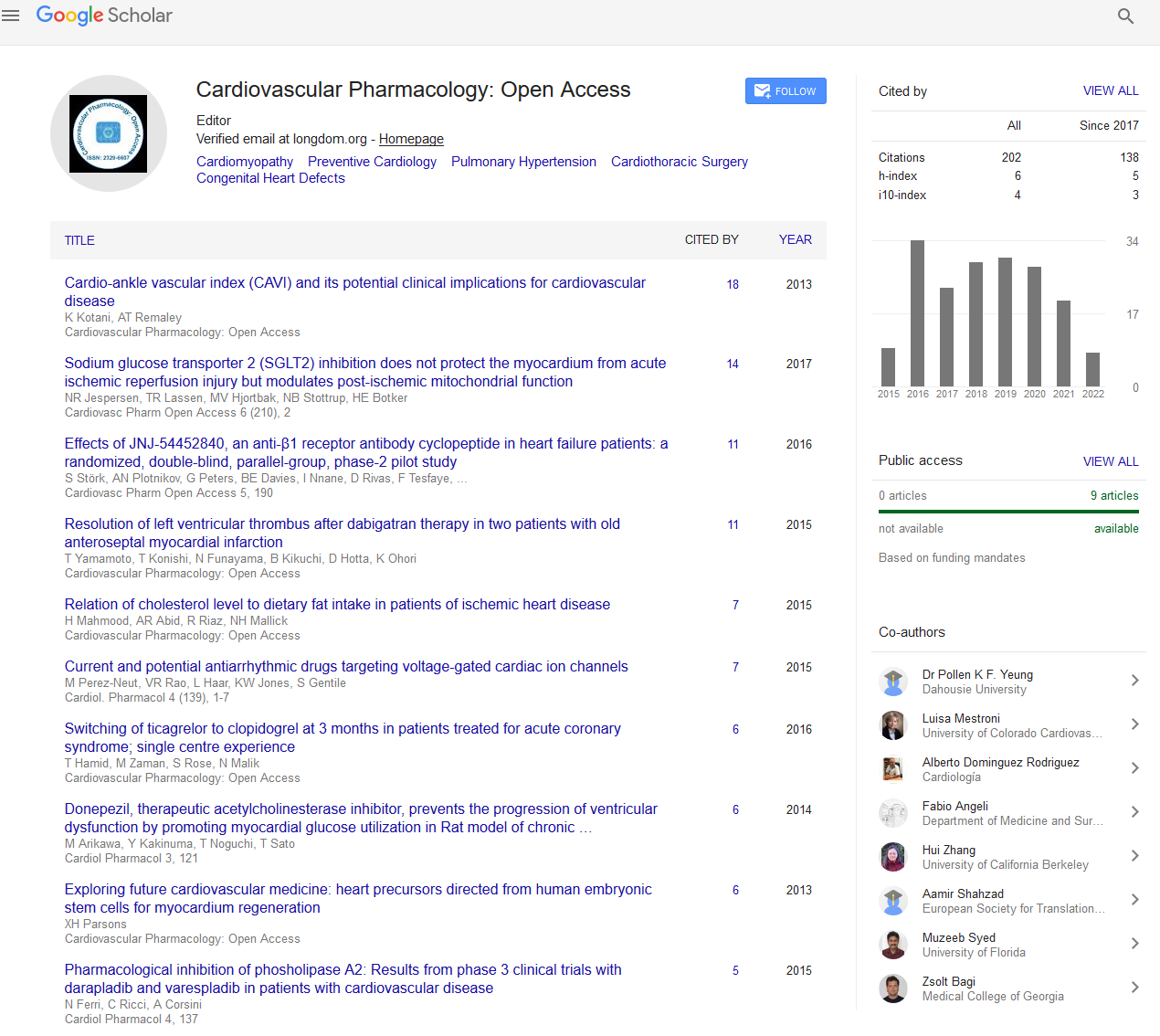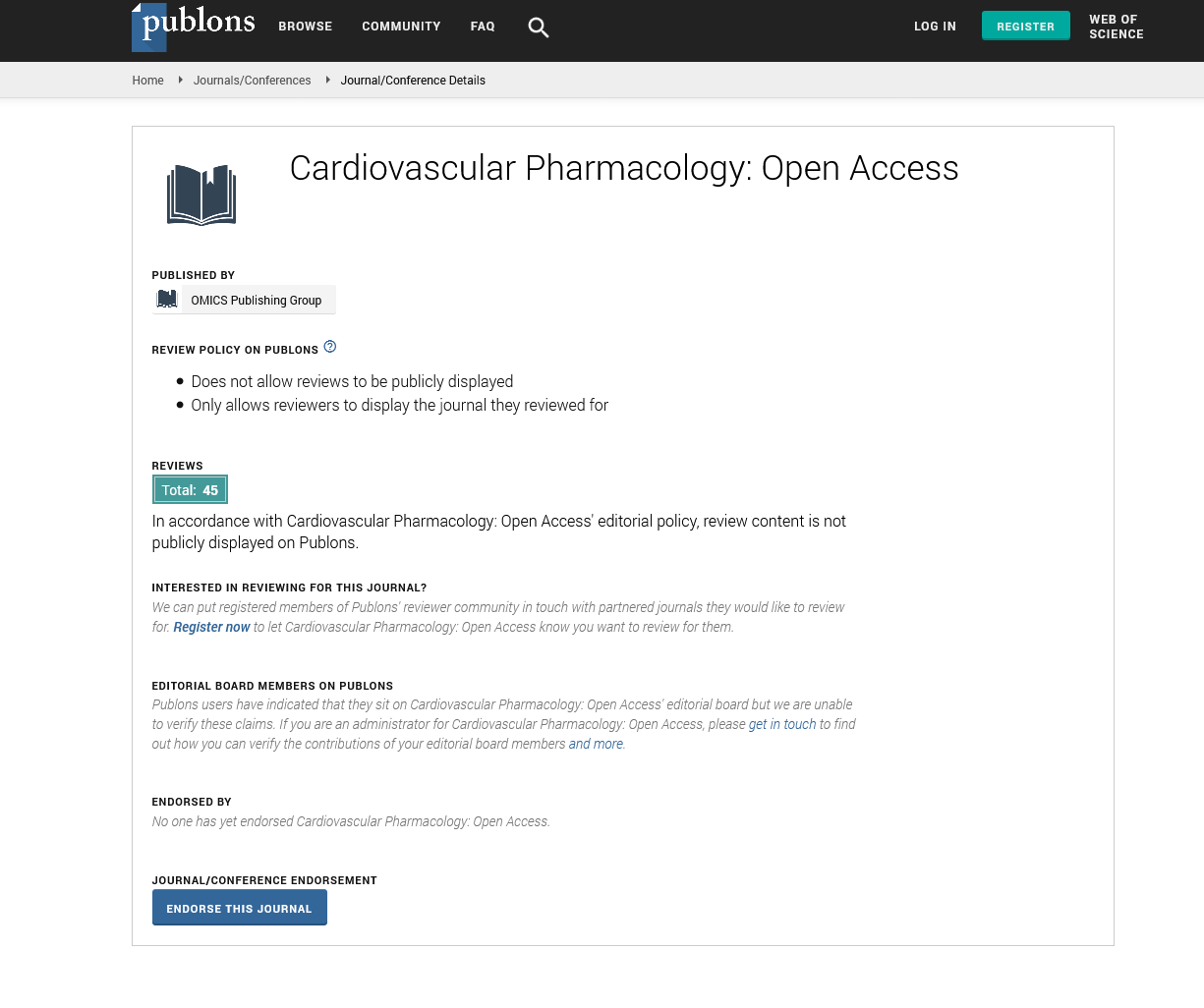Indexed In
- Open J Gate
- Cosmos IF
- RefSeek
- Hamdard University
- EBSCO A-Z
- OCLC- WorldCat
- Publons
- Geneva Foundation for Medical Education and Research
- Euro Pub
- Google Scholar
Useful Links
Share This Page
Journal Flyer

Open Access Journals
- Agri and Aquaculture
- Biochemistry
- Bioinformatics & Systems Biology
- Business & Management
- Chemistry
- Clinical Sciences
- Engineering
- Food & Nutrition
- General Science
- Genetics & Molecular Biology
- Immunology & Microbiology
- Medical Sciences
- Neuroscience & Psychology
- Nursing & Health Care
- Pharmaceutical Sciences
Opinion - (2025) Volume 14, Issue 2
Pharmacological Strategies for Arrhythmia Control in Clinical Practice
Oliver Brown*Received: 29-May-2025, Manuscript No. CPO-25-29835; Editor assigned: 31-May-2025, Pre QC No. CPO-25-29835; Reviewed: 14-Jun-2025, QC No. CPO-25-29835; Revised: 20-Jun-2025, Manuscript No. CPO-25-29835; Published: 28-Jun-2025, DOI: 10.35248/2329-6607.25.14.430
Description
Arrhythmias encompass a wide range of cardiac rhythm disorders, from benign premature beats to severe life-threatening ventricular tachyarrhythmias. Effective pharmacological treatment is crucial for controlling rhythm disturbances, alleviating symptoms and preventing serious complications such as stroke and sudden cardiac death. Antiarrhythmic drugs remain a cornerstone in the management of arrhythmias despite advances in device therapies and catheter ablation.
Antiarrhythmic agents are traditionally classified according to the Vaughan Williams system into four main classes based on their primary electrophysiological effects. Class I drugs, including flecainide and propafenone, function by blocking fast sodium channels, slowing phase 0 depolarization and thereby reducing conduction velocity. These agents are primarily used for supraventricular arrhythmias such as atrial fibrillation and atrial flutter in patients without significant structural heart disease. However, their use is contraindicated in patients with ischemic or structural heart disease due to the risk of proarrhythmia.
Class II agents are beta adrenergic blockers which inhibit sympathetic nervous system activity by antagonizing beta-1 receptors in the heart. This action decreases heart rate, reduces myocardial contractility and suppresses abnormal automaticity. Beta blockers such as metoprolol, atenolol and propranolol are widely used in atrial fibrillation to control ventricular rate and in preventing ventricular arrhythmias following myocardial infarction. Their efficacy in reducing sudden cardiac death in heart failure patients further underscores their importance in arrhythmia management. Class III antiarrhythmic including amiodarone sotalol and dofetilide work by blocking potassium channels which prolongs cardiac repolarization and increases the effective refractory period. This delays reactivation of cardiac tissue and reduces the likelihood of reentrant arrhythmias. Amiodarone is particularly effective for both supraventricular and ventricular arrhythmias and is often used in patients with structural heart disease or heart failure. However long-term therapy requires vigilant monitoring due to its complex side effect profile which includes thyroid dysfunction pulmonary fibrosis hepatotoxicity and skin changes. Sotalol combines class II and class III properties but carries a risk of torsades de pointes, necessitating careful dose titration and ECG surveillance.
Class IV drugs are non-dihydropyridine calcium channel blockers such as verapamil and diltiazem. These agents inhibit L-type calcium channels in the sinoatrial and atrioventricular nodes thereby slowing nodal conduction and decreasing heart rate. They are especially useful in controlling ventricular response in atrial fibrillation and atrial flutter. Unlike beta blockers they can be safely used in patients with reactive airway disease. In selecting antiarrhythmic therapy, the specific arrhythmia type, underlying cardiac pathology and individual patient factors must be carefully considered. For example, while flecainide is effective for atrial fibrillation in structurally normal hearts, amiodarone or sotalol are preferred for arrhythmias in patients with left ventricular dysfunction. Additionally, coexisting conditions such as asthma, renal impairment or thyroid disease influence drug choice.
Pharmacological treatment is often combined with non-drug interventions to optimize outcomes. Catheter ablation techniques targeting arrhythmogenic foci or reentrant circuits have revolutionized care particularly for atrial fibrillation and certain ventricular tachycardias. Implantable Cardioverter Defibrillators (ICDs) provide life-saving shock therapy in patients at risk of sudden cardiac death due to ventricular arrhythmias. Despite these advances antiarrhythmic drugs continue to play a vital role either as primary therapy or adjuncts to procedural interventions. Anticoagulation is a critical component of managing atrial fibrillation to reduce the risk of stroke caused by embolism of atrial thrombi. The choice between vitamin K antagonists and direct oral anticoagulants depends on patient risk profiles, renal function and drug interactions.
One of the major challenges with antiarrhythmic drugs is their potential to cause proarrhythmia paradoxically inducing new or worsening existing arrhythmias. This necessitates cautious patient selection dose titration and frequent ECG monitoring. Side effects and drug interactions further complicate long-term therapy. The narrow therapeutic windows of many agents demand regular clinical and laboratory evaluation to ensure safety. Recent years have seen a growing interest in personalized medicine approaches in arrhythmia management. Genetic testing can identify mutations associated with inherited arrhythmia syndromes such as long QT syndrome Brugada syndrome and catecholaminergic polymorphic ventricular tachycardia. This information can guide drug choice and risk stratification. Detailed electrophysiological studies and advanced cardiac imaging also contribute to tailoring therapy to individual electrophysiological profiles.
Emerging research is focused on developing new antiarrhythmic agents targeting specific ion channel subtypes or molecular pathways involved in arrhythmogenesis. For instance, drugs modulating late sodium current or inward rectifier potassium channels are under investigation. Agents targeting calcium handling abnormalities and gap junction function also hold promise. Such novel therapies aim to improve efficacy and reduce adverse effects compared to current treatments. In addition to new drug development, strategies to improve delivery and adherence are being explored. Extended-release formulations transdermal patches and implantable drug delivery systems may enhance therapeutic consistency and patient compliance. Despite the rapid advances in catheter ablation and device technology pharmacological therapy remains indispensable for arrhythmia control in many clinical scenarios. Its role is expected to persist as new agents and personalized approaches expand the therapeutic landscape.
In conclusion, the pharmacological management of cardiac arrhythmias requires a comprehensive understanding of arrhythmia mechanisms drug actions and patient-specific factors. Antiarrhythmic drugs classified by the Vaughan Williams system continue to be vital tools in controlling rhythm disturbances reducing symptoms and preventing serious complications. Balancing efficacy with safety is paramount given the potential for proarrhythmia and adverse effects. Personalized medicine and ongoing research promise to refine drug choices and introduce novel therapies targeting underlying molecular mechanisms. Until then careful patient selection close monitoring and integration with procedural interventions remain essential in optimizing outcomes in arrhythmia management.
Citation: Brown O (2025) Pharmacological Strategies for Arrhythmia Control in Clinical Practice
Copyright: © 2025 Brown O. This is an open access article distributed under the terms of the Creative Commons Attribution License, which permits unrestricted use, distribution AND reproduction in any medium, provided the original author and source are credited.


